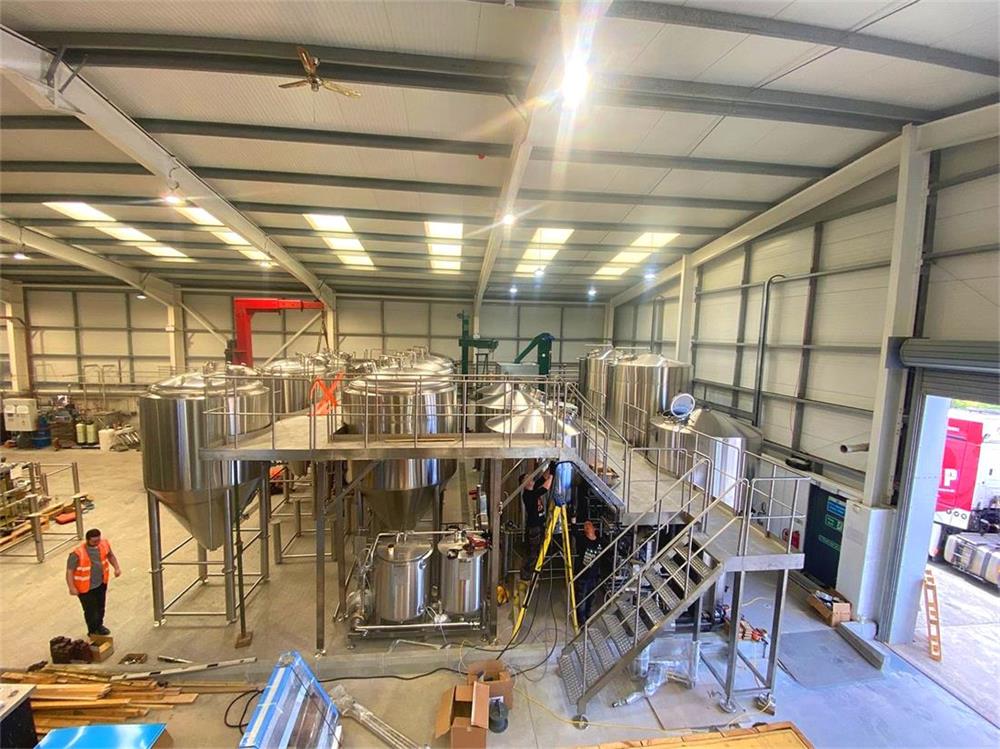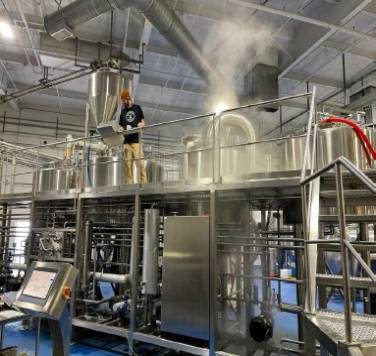BBL Fermenters
What is a BBL Fermenter?
The term “bbl” stands for “barrel,” a unit used to measure the volume of liquids, particularly in brewing. In the context of fermenters, a BBL fermenter is a vessel specifically designed to house and control the fermentation process of beer. These fermenters come in various sizes, with 1 BBL and 4 BBL being the most common options for homebrewers and small craft breweries.
Why Use a BBL Fermenter?
For homebrewers, BBL fermenters offer a step-up from carboys or buckets, providing several advantages:
- Increased Capacity: BBL fermenters allow you to brew larger batches, perfect for sharing your creations or experimenting with new recipes.
- Improved Temperature Control: Many BBL fermenters are jacketed, meaning they have a double wall that can circulate coolant or heat, enabling precise temperature regulation throughout fermentation, which is crucial for optimal flavor and quality.
- Professional Features: BBL fermenters often incorporate features like pressure gauges, sample ports, and racking arms, mimicking professional brewing equipment and offering a more streamlined brewing experience.
For craft breweries, BBL fermenters serve as versatile workhorses:
- Pilot Batching: Small-scale breweries can utilize BBL fermenters to test new recipes or create limited-edition batches before committing to larger production volumes.
- Space Optimization: BBL fermenters offer a space-saving solution compared to massive tanks, allowing breweries to maximize their production capacity within a limited footprint.
- Scalability: As a brewery expands, they can easily add more BBL fermenters to their operation without completely overhauling their existing infrastructure.

Types of BBL Fermenters
Here’s a breakdown of the two most common types of BBL fermenters:
| BBL Fermenter Type | Description | Advantages | Disadvantages |
|---|---|---|---|
| Unitank Fermenters | These multi-functional tanks combine fermentation, conditioning, and serving functions into a single vessel. | Simplifies the brewing process, reduces equipment footprint | Generally more expensive than single-purpose fermenters |
| Conical Fermenters | These vessels feature a conical bottom that allows for easier collection of yeast sediment (trub) during fermentation. | Improves beer clarity, facilitates yeast harvesting | May require additional equipment for transferring beer for secondary fermentation or bottling. |
The Brewing Process with BBL Fermenters
The brewing process using BBL fermenters follows the same general principles as with any other fermenter, but with the benefit of the aforementioned advantages:
- Wort Transfer: Once your wort (unfermented beer) is prepared, it’s transferred from the brew kettle to the sanitized BBL fermenter.
- Pitching Yeast: Yeast is then introduced into the wort to initiate fermentation.
- Fermentation: During this stage, the yeast consumes the sugars in the wort and produces alcohol and carbon dioxide. BBL fermenters, particularly jacketed versions, allow for precise temperature control, which is essential for achieving the desired beer style and flavor profile.
- Maturation (Optional): Some beer styles benefit from secondary fermentation or conditioning in a separate vessel. With conical fermenters, transferring the clarified beer (without the sediment) to a secondary fermenter is easier.
- Packaging: Once fermentation is complete and the beer has conditioned, it’s prepared for packaging in kegs or bottles.
BBL Fermenter Specifications
Here’s a table outlining key specifications to consider when choosing a BBL fermenter:
| Specification | Description |
|---|---|
| Capacity | Typically 1 BBL (31 gallons) or 4 BBL (124 gallons) |
| Material | Typically constructed from 304-grade stainless steel for durability and sanitation |
| Finish | Interior: Polished for easy cleaning; Exterior: May come in brushed or polished finishes |
| Jacketing | Single shell or jacketed (double wall for temperature control) |
| Insulation | Optional for improved temperature control, especially for lagers or ales requiring colder fermentation temperatures |
| Lids | May have a top lid for access and a separate manway for cleaning and inspection |
| Valves | Sample ports, racking arms, and pressure relief valves are common features |
| Accessories | May include thermometers, pressure gauges, and CIP (Cleaning In Place) spray balls |
BBL Fermenter Price Range
The cost of a BBL fermenter varies depending on several factors, including:
- Size: As mentioned earlier, 4 BBL fermenters are generally more expensive than 1 BBL models.
- Features: Jacketed fermenters with features like temperature control systems, CIP spray balls, and multiple ports will command a higher price tag compared to basic, single-shell models.
- Material: High-quality stainless steel construction will factor into the cost.
- Brand: Reputable brands with established track records in brewing equipment may have slightly higher prices compared to lesser-known manufacturers.
Here’s a table outlining a typical price range for BBL fermenters:
| BBL Fermenter Type | Features | Price Range (USD) |
|---|---|---|
| Basic 1 BBL Fermenter (Single Shell) | No Jaceting, limited features | $1,500 – $2,800 |
| Standard 1 BBL Fermenter (Jacketed) | Temperature control jacket, basic valves | $2,900 – $4,500 |
| Feature-Rich 1 BBL Fermenter | Jacketed, CIP spray ball, multiple ports, level indicators | $4,500 – $6,000 |
| Basic 4 BBL Fermenter (Single Shell) | No Jaceting, limited features | $4,000 – $6,000 |
| Standard 4 BBL Fermenter (Jacketed) | Temperature control jacket, basic valves | $6,000 – $8,000 |
| Feature-Rich 4 BBL Fermenter | Jacketed, CIP spray ball, multiple ports, level indicators | $8,000 – $12,000+ |
Suppliers of BBL Fermenters
When selecting a BBL fermenter supplier, consider factors like:
- Reputation: Look for established companies with a proven track record in brewing equipment manufacturing.
- Customer Service: Reliable customer service is crucial for getting assistance with setup, troubleshooting, or spare parts.
- Warranty: A good warranty demonstrates the manufacturer’s confidence in the product’s quality.
Here’s a table listing some reputable suppliers of BBL fermenters:
| Supplier | Location | Website |
|---|---|---|
| MoreBeer! Pro | USA | https://www.morebeer.com/category/pro-fermenters.html |
| Stout Tanks and Kettles | USA | https://conical-fermenter.com/ |
| Glacier Tanks | USA | https://www.glaciertanks.com/ |
| Bolton Tools | USA | https://www.boltontool.com/ |
| Ace Stills | USA | https://www.blichmannengineering.com/1-bbl-fermenter.html |
Installation, Operation, and Maintenance of BBL Fermenters
Installation:
- BBL fermenters, particularly larger 4 BBL models, may require professional installation to ensure proper placement, leveling, and connection to utilities.
- For smaller BBL fermenters, some manufacturers may offer DIY installation instructions.
Operation:
- BBL fermenters, especially those with advanced features, may come with detailed manuals outlining operational procedures for temperature control, fermentation monitoring, and transferring beer.
- Familiarize yourself with the specific controls and features of your chosen BBL fermenter model.
Maintenance:
- Proper cleaning and sanitation are essential for maintaining the integrity of your BBL fermenter and producing high-quality beer.
- BBL fermenters, particularly jacketed models, may have specific cleaning procedures using hot water, cleaning solutions, and CIP systems.
- Refer to the manufacturer’s recommendations for cleaning and sanitation practices.

Choosing the Right BBL Fermenter
Here’s a table to help you choose the right BBL fermenter for your needs:
| Factor | Consideration |
|---|---|
| Batch Size: | How much beer do you typically brew per batch? |
| Available Space: | How much space do you have for the fermenter? |
| Budget: | How much are you willing to spend? |
| Features: | Do you need basic functionality or advanced temperature control and other features? |
| Expandability: | Do you plan to scale up production in the future? |
Here are some additional tips for choosing a BBL fermenter:
- Research different brands and models: Read reviews, compare features, and get quotes from multiple suppliers.
- Consider your brewing experience: If you’re a homebrewer just starting with BBL fermenters, a basic model might suffice. As you gain experience and brew larger batches, you can invest in a more feature-rich fermenter.
- Think about future expansion: If you envision opening a small brewery or significantly increasing your production volume, a 4 BBL fermenter might be a better long-term investment compared to a 1 BBL model.
Pros and Cons of BBL Fermenters
Pros:
- Increased Capacity: Allows you to brew larger batches of beer, perfect for sharing or experimenting with recipes.
- Improved Temperature Control: Jacketed BBL fermenters enable precise temperature control, leading to consistent and high-quality brews.
- Professional Features: Many BBL fermenters offer features like pressure gauges, sample ports, and racking arms, streamlining the brewing process.
- Scalability: BBL fermenters are modular; you can add more fermenters as your production needs grow.
- Space-saving (for breweries): Compared to massive tanks, BBL fermenters allow breweries to optimize their production area.
Cons:
- Cost: BBL fermenters, especially feature-rich jacketed models, can be a significant investment.
- Space Requirements: Even 1 BBL fermenters require dedicated space in your homebrew setup or brewery.
- Complexity (for some models): Jacketed BBL fermenters with advanced features may have a steeper learning curve compared to basic carboys or buckets.
FAQ
Here’s a table addressing some frequently asked questions regarding BBL fermenters:
| Question | Answer |
|---|---|
| What is the difference between a BBL fermenter and a carboy? | BBL fermenters are much larger than carboys (typically 1 gallon or 5 gallons), allowing for bigger batches. BBL fermenters are also often constructed from stainless steel for durability and jacketed for temperature control, features absent in most carboys. |
| Do I need a BBL fermenter as a homebrewer? | Not necessarily. Carboys are perfectly functional for small-scale brewing. However, BBL fermenters offer advantages like larger batch sizes, improved temperature control, and a more professional brewing experience. |
| How do I clean a BBL fermenter? | Cleaning procedures can vary depending on the specific BBL fermenter model. Generally, a hot water sanitation process or a Cleaning In Place (CIP) system with cleaning solutions is used. Always refer to the manufacturer’s instructions for proper cleaning and sanitation practices. |
| What is the best BBL fermenter? | The “best” BBL fermenter depends on your individual needs and budget. Consider factors like batch size, available space, features required, and your brewing experience. Research different brands and models to find the one that best suits your needs. |
Share this entry
Interested in learning more about Brewing Systems including additional details and pricing information? Please use the form below to contact us!
YOLONG BREWERY EQUIPMENT FAQS
- Commercial Brewery / Craft Brewery / Microbrewery / Nanobrewery
- What is The Difference Between Craft Beer and Industrial Beer?
- The Bespoke Differences In Custom Brewing Systems
- Everything You Need to Know About Kettle Souring
- How to Choose Brewing Equipment for Your business?
- How To Choose The-Best Partner To Build Your Commercial Microbrewing System?
- Two Detection Sensors That You Need To Use In Your Brewhouse System
- Remote Control Applications in Brewing Equipment/How does it work?
- How To Clean Your Brand New Brewery Tanks?

